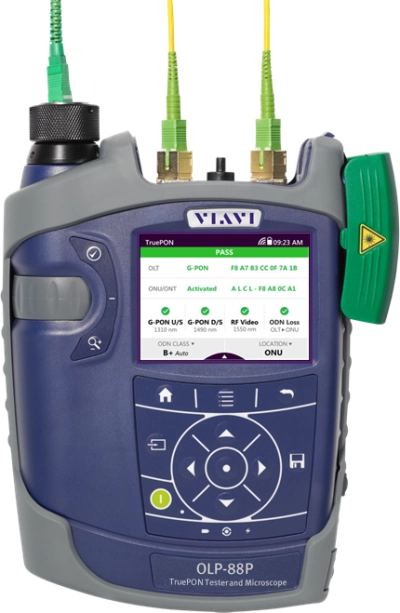SmartClass Fiber OLP-88 TruePON Tester
Ensure fast and accurate service activation and troubleshooting with integrated GPON data analysis
The OLP-88 TruePON tester is the first instrument in the market with test capabilities like OLT and ONU identification, ONT activation process verification, automatic PON power levels certification, in-service insertion loss test and Alien/Rogue ONUs detection. Together with accurate downstream and upstream power level measurements the OLP-88 ensures more reliable PON tests and faster trouble shooting of network issues. The built-in G-PON data analysis simplifies and speeds up installation workflows by automatically providing all necessary information about the system to the service technician.
Learn more about Fiber Testing, Passive Optical Networks (PON), and XGS-PON.
Benefits
- Ensures first time right GPON network acceptance
- Reduces workflow complexity during service activation
- Speeds-up on-site troubleshooting and facilitate service recovery
- Drives user workflow and behavior to eliminate the issues caused by poor practices.
Applications
- GPON ONT activation process verification
- OLT and ONT identification (serial number extraction)
- Automatic power level measurement and certification for Passive Optical Network (PON) signals
- In-service fiber plant qualification
- Rogue ONUs or alien devices identification
- Automated pass/fail fiber end-faces analysis -- learn more about fiber inspection best practices
Key Features
- Simple and user-friendly color touchscreen
- Compact and lightweight instrument (<1kg)
- Data storage of up to 10.000 test results
- USB, Ethernet and WiFi interfaces
- 12 hours of battery life
- Patchcord microscope version and P5000i digital inspection probe compatibility
Software Download
Application Notes
Brochures
Data Sheets
Quick References
Selection Guides
Services
Software Download
Care Support Plans
| Product Group | Recommended Plan | Bronze | Silver | Maxcare | |
|---|---|---|---|---|---|
| SmartClass Fiber (OLP-87/OLP-88) (PON Power Meters) | Silver-5 | Does the product require calibration? Common questions or issues |
-
VIAVI Care Support
Services Bronze Silver MaxCare Image Image
Image Image
Image
Technical Assistance Premium Premium Premium Factory Repair Priority Service Self-paced Training Factory Calibration Express Loaner * 5-year plans only; if applicable
-
VIAVI Care Support for Existing Equipment
FleetCare plans can be customized to include any service entitlements on your fleet of existing equipment. Please fill out a Service Contracts form for a quote.
- Any collection instruments with a single coterminous renewal date
- Each contract is customized with any number of annual terms required by the customer
- Onsite Calibration, Training, Field Application Engineer days can be added
Training Courses
Training Courses
Related Products
Support at Every Step
We provide support, services, comprehensive training and the resources you need. It’s all part of what we do to maximize the value of your VIAVI investment.
Let Us Help
We’re here to help you get ahead.



